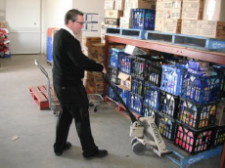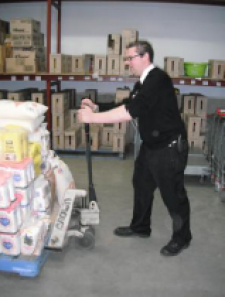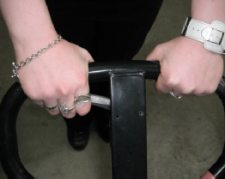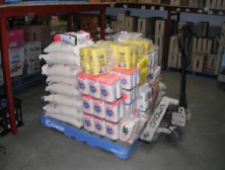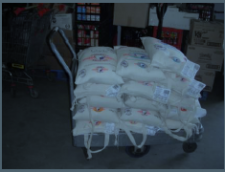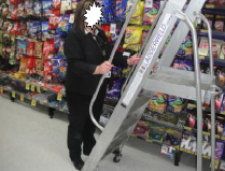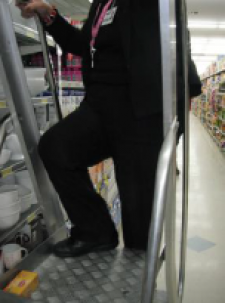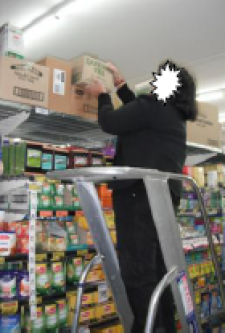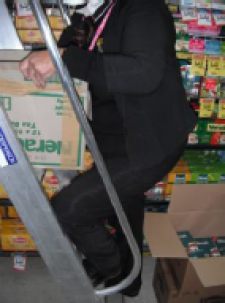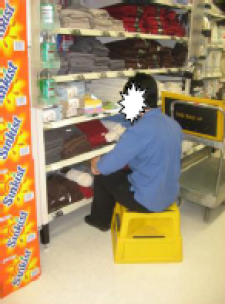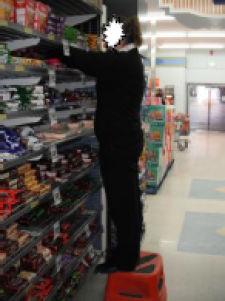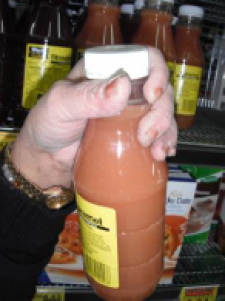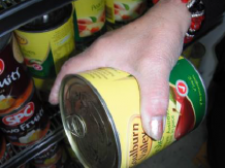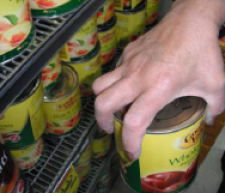Physical demands - grocery store worker - general
Note
Please note these images are for illustrative purposes only to provide a basic understanding of the tasks involved for this job. They do not necessarily represent compliant or best practice safe work.
Stock handling at rear of store
Description of photos
- The store size and location determined the number of deliveries of stock per week. Multiple pallets of goods are delivered by truck and shifted by forklift to the rear of store to the shelves in the store room.
- Workers then handled pallets by pallet jack to break down loads to relevant aisles. Pump forces to elevate the pallet off the ground (photo 1) did not seem to vary greatly for different pallet loads, and was approximately 11kg. The pallet jack handle was gripped as seen in photo 3 with bilateral power grip in pronation with right hand fingers operating the release lever. The handles were at waist height to minimise stooping. Pallet jacks converted push (photo 2) and pull (photo 1) forces to 2-4% of the weight of the load, e.g.
- for the heaviest pallet, being the flour sacks (640kg), the pump force was 11kg, and the inertia-overcoming force to commence or restrain motion was ~20kg depending on rate of acceleration (pace at which the worker pushed or pushed), and in-motion push/pull forces were less
- for a 450kg pallet load, pump force was 11kg, and 10kg force was required to commence or restrain motion and less to keep in motion
- for a 300kg pallet load, pump force was 11kg, and 6kg force was required to commence or restrain motion and less to keep in motion.
- Depending on store policy, goods were transferred from the storerooms at rear to the shop floor via pallet jack or flat top trolley or shopping trolley. The flat top trolley is seen in photo 5-6. Handles were at 800mm. Flat top trolleys were easy to manoeuvre with a central pivoting axle. Again push/pull forces were only a fraction of vertical load, in this case 3-4% for the flat tops.
- For the heaviest trolley, being the flour sacks x15 (150kg) or cartons of soft drink x10 (158kg), the inertia-overcoming force to commence or restrain motion was ~10-12kg depending on rate of acceleration, and in-motion push/pull forces were 5-7kg.
Physical capacity/demands
Standing, walking, reaching <120° elevation, bending or squatting to floor, lifting 1-20kg from floor to waist height, pulling/pushing pallet jack and flat top trolley <11kg, gross handling.
Merchandising
Description of photos
- Goods were transferred from storeroom to shop floor (photos 6-7).
- Items were broken down from cartons and placed on the shelves (photos 12-14). Shelves were adjusted to suit the stock lines. The lowest shelves were 200mm off the floor and the highest was 1900mm. The overstock shelf (top of shelving system) was at 2200mm.
- In principle the worker needed to keep their arms at or around 90o elevation to be able to reach into the rear of 500-600mm deep shelves (photo 12, 14).
- Floor height was adjusted by use of a safety step for mid-high shelves (photo 14); it raised floor level to 350mm and weighed 5kg.
- The aluminium step ladder was used for highest shelves. It was light-weight to push on its locking castors. There were 3 steps at 300mm increments requiring about 90° knee flexion (photo 9). The platform was at 1000mm (photo 9-10)
- Any surplus/”overstock” was left in the cartons and placed on the “overheads” (photo 9-11). On days where there were no deliveries to store, the overhead stock was pulled down to be placed on the shelves. There were rarely full cartons placed overhead; usually surplus only. Indicative full loads in grocery were:
- coffee 500g x 6 = 3kg, sugar 1kg x 12 = 12kg, vinegar 2litre x 6 = 12kg, rice 5kg x 3 = 15kg, glassware 22kg.
- Grip types observed depended on weight and shape of the item and appear in photos 15-18.
- To check stock, and order for delivery, grocery worker would circulate with a hand held scanner, paper and pen to record delivery requirements.
Physical capacity/demands
Standing, walking, reaching <135° elevation, bending or squatting to floor, climbing steps/ladders, lifting 1- 20kg from floor to waist and <15kg waist to overhead, pulling/pushing pallet jack and flat top trolley <11kg, gross handling ad various dexterity grips.
More return to work resources
- Download the return to work checklist (PDF, 0.04 MB) for Grocery store worker
- View job task analysis for Grocery store worker – general
